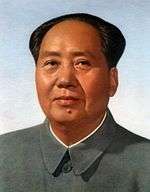Three Worlds Theory
| Part of a series on |
| Maoism |
|---|
 |
|
The Three Worlds Theory (simplified Chinese: 三个世界的理论; traditional Chinese: 三個世界的理論; pinyin: Sān gè Shìjiè de Lǐlùn), developed by Chinese Communist leader Mao Zedong, posited that international relations comprise three politico-economic worlds: the first world consisting of superpowers, the second world of lesser powers, and the third world of exploited nations.[1]
Notably, Chairman Mao included the US and the Soviet Union in the First World group of countries which, respectively, engaged in imperialism and social imperialism. Japan, Europe, and Canada composed the Second World under this theory as developed, Northern countries. Africa, Latin America, and the whole of Asia except Japan formed the Third World.[2] In 1974, then Chinese Vice-Premier Deng Xiaoping explained the Three Worlds Theory in a speech to the United Nations at the special session of the United Nations General Assembly on the problems of raw materials and development, the 6th special session, in April 1974, justifying China's cooperation with non-communist countries.[3]
The Three Worlds Theory developed by Mao Zedong should not be confused with the Western Three-World Model which states that the First World comprises the United States and United Kingdom and their allies, the Second World the Soviet Union and China and their allies, and the Third World the neutral and nonaligned countries. Mao's division of the worlds highlighted what he considered to be the patterns of exploitation rather than diplomacy or formal ideology.
Criticism
Some anti-revisionist political parties and organizations were disillusioned by the Three Worlds Theory. Subsequently, in Albania, Enver Hoxha, leader of the Party of Labour of Albania, posited an ideological alternative, opposed to both the Three Worlds Theory and to the Communist Party of the Soviet Union’s stance. This led to the Sino-Albanian split among communist parties previously aligned with China and Albania.
The Revolutionary Internationalist Movement and the Maoist Internationalist Movement, founders of the modern Maoist movement, were also highly critical of Three Worlds Theory and left it completely out of their respective programs, considering it to fall under the banner of Mao-Zedong-Thought rather than Marxism-Leninism-Maoism.
See also
References
- ↑ "Chairman Mao's Theory of the Differentiation of the Three Worlds is a Major Contribution to Marxism-Leninism". People's Daily.
- ↑ Gillespie, Sandra (2004). "Diplomacy on a South-South Dimension". In Slavik, Hannah. Intercultural Communication and Diplomacy. Diplo Foundation. p. 123.
- ↑ Teng Hsiao-ping (April 12, 1974). "Excerpts From Chinese Address to U. N. Session on Raw Materials; Plundering, Bullying' High-Handed Measures' Independent Development". The New York Times. Retrieved February 21, 2015.
External links
- On the Question of the Differentiation of the Three Worlds
- Communist Party of China - The letter in 25 points
- Renmin Ribao on the Three Worlds Theory
- Speech by Deng Xiaoping at the Special Session of the U.N. General Assembly
- Enver Hoxha: Imperialism and the Revolution - Part Two
- Communist Party of Peru on the three worlds
- Communist Party of Turkey/Marxist-Leninist on the three worlds
- Red Army Fraction: statement made on November 1972